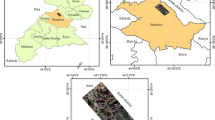Abstract
Accurate crop classification is one of the most important applications of remote sensing. This task becomes more challenging when the agricultural fields are smallholdings and heterogeneous. This study intends to address this issue with the synergistic use of synthetic aperture radar data of Sentinel-1 and multispectral data of Sentinel-2 in the Cauvery delta zone. Single date reflectance values and spectral indices from Sentinel-2 data were used along with the multi-temporal dual-pol backscatter data from Sentinel-1 data to train random forest classifier. The multi-sensor Sentinel dataset achieved the highest accuracy score and Cohen’s kappa value of 0.990 and 0.989.
Access this chapter
Tax calculation will be finalised at checkout
Purchases are for personal use only
Similar content being viewed by others
References
Skriver H (2012) Crop classification by multi-temporal c- and l-band single and dual-polarization and fully polarimetric SAR. 50
Lu D, Weng Q (2007) A survey of image classification methods and techniques for improving classification performance. 28
Bargiel D, Herrmann S (2011) Multi-temporal land-cover classification of agricultural areas in two European regions with high resolution spotlight TerraSAR-X data. 3
Forkuor G, Conrad C, Thiel M, Ullmann T, Zoungrana E (2014) Integration of optical and synthetic aperture radar imagery for improving crop mapping in north-western Benin, West Africa. Remote Sens 6(7)
Chakraborty M, Panigrahy S, Sharma SA (1997) Discrimination of rice crop grown under different cultural practices using temporal ERS-1 synthetic aperture radar data. ISPRS J Photogramm Remote Sens 52(4):183–191
Kobayashi N, Tani H, Wang X, Sonobe R (2020) Crop classification using spectral indices derived from Sentinel-2A imagery. J Inf Telecommun. 4(1):67–90
Jain A, Singh D (2016) Decision tree approach to classify the fully polarimetric RADARSAT-2 data. In: RAECE 2015—conference proceedings, national conference on recent advances in electronics computer engineering, pp 318–323
Lohse J, Doulgeris AP, Dierking W (2019) An optimal decision-tree design strategy and its application to sea ice classification from SAR imagery. Remote Sens 11(13)
Zhang Y, Zhang J, Zhang X, Wu H, Guo M (2015) Land cover classification from polarimetric SAR data based on image segmentation and decision trees. Can J Remote Sens 41(1):40–50
Mishra VN, Prasad R, Kumar P, Srivastava PK, Rai PK (2017) Knowledge-based decision tree approach for mapping spatial distribution of rice crop using C-band synthetic aperture radar-derived information. J Appl Remote Sens 11(04):1
Sonobe R, Tani H, Wang X, Kobayashi N, Shimamura H (2014) Random forest classification of crop type using multi-temporal TerraSAR-X dual-polarimetric data. Remote Sens Lett 5(2):157–164
Waske B, Heinzel V, Braun M, Menz G (2007) Random forests for classifying multi-temporal SAR data. Eur. Sp. Agency, (Special Publ. ESA SP) 2007(SP-636)
Millard K, Richardson M (2015) On the importance of training data sample selection in random forest image classification: a case study in peatland ecosystem mapping. Remote Sens 7(7):8489–8515
Ramathilagam AB, Haldar D (2021) Evaluation of different machine learning algorithms for pearl millet discrimination using multi-sensor SAR data. Geocarto Int
Son NT, Chen CF, Chen CR, Minh VQ (2018) Assessment of Sentinel-1A data for rice crop classification using random forests and support vector machines. Geocarto Int 33(6):587–601
Sonobe R, Tani H, Wang X, Kobayashi N, Shimamura H (2014) Parameter tuning in the support vector machine and random forest and their performances in cross- and same-year crop classification using TerraSAR-X. Int J Remote Sens 35(23):7898–7909
Nelson A et al (2014) Towards an operational SAR-based rice monitoring system in Asia: examples from 13 demonstration sites across Asia in the RIICE project. Remote Sens 6(11):10773–10812
Copernicus open access hub (2021). https://scihub.copernicus.eu/dhus/#/home
Belgiu M, Drăgu L (2016) Random forest in remote sensing: a review of applications and future directions. ISPRS J Photogramm Remote Sens 114:24–31
Pedregosa F et al (2011) Scikit-learn: machine learning in python. J Mach Learn Res 12(85):2825–2830
Panigrahy S, Chakraborty M, Sharma SA, Kundu N, Ghose SC, Pal M (1997) Early estimation of rice area using temporal ERS-1 synthetic aperture radar data—a case study for the Howrah and Hughly districts of West Bengal, India. Int J Remote Sens 18(8):1827–1833
Acknowledgements
The authors would like to thank the Indian Space Research Organization (ISRO) for supporting this research work via the ISRO RESPOND project ISRO/RES/4/685/20-21.
Author information
Authors and Affiliations
Corresponding author
Editor information
Editors and Affiliations
Rights and permissions
Copyright information
© 2022 The Author(s), under exclusive license to Springer Nature Singapore Pte Ltd.
About this paper
Cite this paper
Ramathilagam, A.B., Natarajan, S., Kumar, A. (2022). Crop Classification in the Cauvery Delta Zone Using Machine Learning on Multi-Sensor Data. In: Kumar, R., Ahn, C.W., Sharma, T.K., Verma, O.P., Agarwal, A. (eds) Soft Computing: Theories and Applications. Lecture Notes in Networks and Systems, vol 425. Springer, Singapore. https://doi.org/10.1007/978-981-19-0707-4_20
Download citation
DOI: https://doi.org/10.1007/978-981-19-0707-4_20
Published:
Publisher Name: Springer, Singapore
Print ISBN: 978-981-19-0706-7
Online ISBN: 978-981-19-0707-4
eBook Packages: Intelligent Technologies and RoboticsIntelligent Technologies and Robotics (R0)




